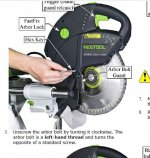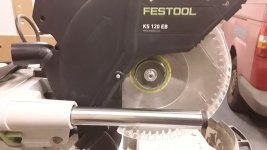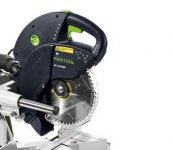You are using an out of date browser. It may not display this or other websites correctly.
You should upgrade or use an alternative browser.
You should upgrade or use an alternative browser.
What is this for?
- Thread starter festal
- Start date
Packard
Member
ChuckS said:Bolt guard. I think it's there to prevent a wrong hex key from being used on the arbor nut as you need to use the same supplied hex key to loosen the bolt guard and to unscrew the arbor nut:
[attachimg=1]
Really? They are guarding you against using the wrong size Allen wrench? The engineers have so little faith in the customers?
It would be easier (and cheaper) to color code the bolts and the Allen wrenches.
I think there must be another reason—something non-intuitive.
Perhaps, when cutting very thick stock, it prevents the arbor bolt from rubbing against the stock.
Bohdan
Member
The plate is there to stop the bolt from unscrewing and falling out, when the brake is applied, if the bolt has not been secured properly.
Happened on mine after a person not familiar with the saw changed the blade. Mine didn't have the plate, the bolt spun out and dropped the spinning blade onto the guard.
A safety feature that I wish they had not dropped. [crying]
Happened on mine after a person not familiar with the saw changed the blade. Mine didn't have the plate, the bolt spun out and dropped the spinning blade onto the guard.
A safety feature that I wish they had not dropped. [crying]
Packard
Member
Bohdan said:The plate is there to stop the bolt from unscrewing and falling out, when the brake is applied, if the bolt has not been secured properly.
Happened on mine after a person not familiar with the saw changed the blade. Mine didn't have the plate, the bolt spun out and dropped the spinning blade onto the guard.
A safety feature that I wish they had not dropped. [crying]
That makes some sense.
It could make a pretty lethal frisbee.
I did some google research and this topic has come up in the past on FOG, but this is the first reason that I’ve read that makes sense to me. It is a thoughtful design that requires one wrench for both the guard and the arbor bolt.
Cheese
Member
Bohdan said:The plate is there to stop the bolt from unscrewing and falling out, when the brake is applied, if the bolt has not been secured properly.
Ya, it's annoying the first time around but a god-send once you realize why it was implemented.
Distinctive Interiors
Member
- Joined
- Apr 17, 2012
- Messages
- 452
Packard
Member
This thread reminded me of an accident that occurred in my friend’s metal stamping factory. They stamped out metal “cans” by a process known as “deep drawing”. These “cans” could be shallow dishes or deep round or shaped cans.
The process was as follows:
1. Stamp out the “blank” from which the can would be drawn
2. Place the blank in the press that held a male and female shape of the can
3. Allow the press to cycle (a very slow moving ram would force the male tool into the female tool.)
4. Trim the excess.
Note: The sexist terms “male” and “female” are standard in the punch press industry.
For the last step, trimming, there were two methods. Build a tool to trim off the excess and trim in the punch press.
Or, if it was a round shape, they had what was effectively a giant can opener. The operator would press down on a 2 foot long lever and step on a switch. The can would then spin and the lever would press the round cutter into the steel and trim off the excess.
It was important to allow the spinning to stop before lifting the lever. On one occasion the operator got the sequence reversed and lifted the lever while the part was still spinning.
That allowed the trim to separate from the can while spinning and take flight like a steel frisbee. It flew across the factory and struck my friend on the arm. It sliced through all the skin, muscle, tendons and ligaments in the forearm, but did not damage his radius or ulna (bones).
This was in 1966 or 1967. He was rushed to the hospital where he was treated by a surgeon in a new specialty and called himself a “hand doctor”. He re-attached the muscle, tendons and ligaments and nerves, and stitched the skin neatly to hide his craftsmanship.
He regained all use of his hand, though they had to go back in to cauterize some of the nerves as everything he touched hurt.
I would imagine that a flying carbide saw blade is capable of even greater damage, especially since that “can opener” only spun at a few hundred RPMs (I would guess between 100 and 300 RPMS).
Not only would a Flying Festool be sharper and more damaging, it would be spinning at a much higher rate. In my mind, it could decapitate someone (and they have not, as yet, figured how to re-attach a head to a body).
So that arbor nut safety prevents the arbor nut or bolt from completely separating and allowing the blade to become a lethal frisbee. I would think it would be mandatory for all chop saws.
This kind of accident would not happen often, but when it did, it had the potential to be very messy.
My friend, a “half full” and not a “half empty” person, said that the one good thing that happened was that the business could not get sued. That, of course being based on the fact that the only person that got hurt was the owner of the business. He was in a cast for about 4 or 5 months. [eek]
The process was as follows:
1. Stamp out the “blank” from which the can would be drawn
2. Place the blank in the press that held a male and female shape of the can
3. Allow the press to cycle (a very slow moving ram would force the male tool into the female tool.)
4. Trim the excess.
Note: The sexist terms “male” and “female” are standard in the punch press industry.
For the last step, trimming, there were two methods. Build a tool to trim off the excess and trim in the punch press.
Or, if it was a round shape, they had what was effectively a giant can opener. The operator would press down on a 2 foot long lever and step on a switch. The can would then spin and the lever would press the round cutter into the steel and trim off the excess.
It was important to allow the spinning to stop before lifting the lever. On one occasion the operator got the sequence reversed and lifted the lever while the part was still spinning.
That allowed the trim to separate from the can while spinning and take flight like a steel frisbee. It flew across the factory and struck my friend on the arm. It sliced through all the skin, muscle, tendons and ligaments in the forearm, but did not damage his radius or ulna (bones).
This was in 1966 or 1967. He was rushed to the hospital where he was treated by a surgeon in a new specialty and called himself a “hand doctor”. He re-attached the muscle, tendons and ligaments and nerves, and stitched the skin neatly to hide his craftsmanship.
He regained all use of his hand, though they had to go back in to cauterize some of the nerves as everything he touched hurt.
I would imagine that a flying carbide saw blade is capable of even greater damage, especially since that “can opener” only spun at a few hundred RPMs (I would guess between 100 and 300 RPMS).
Not only would a Flying Festool be sharper and more damaging, it would be spinning at a much higher rate. In my mind, it could decapitate someone (and they have not, as yet, figured how to re-attach a head to a body).
So that arbor nut safety prevents the arbor nut or bolt from completely separating and allowing the blade to become a lethal frisbee. I would think it would be mandatory for all chop saws.
This kind of accident would not happen often, but when it did, it had the potential to be very messy.
My friend, a “half full” and not a “half empty” person, said that the one good thing that happened was that the business could not get sued. That, of course being based on the fact that the only person that got hurt was the owner of the business. He was in a cast for about 4 or 5 months. [eek]
Distinctive Interiors said:I bought my Kapex new 10 years ago here in the UK......It does not have that tab on the saw!...??
Is it an addition that Festool added for the North American market...?
Edit.
Photo added.
[attachimg=1]
Safety was the first reason I guessed in my reply, but then I changed it after noting the OP's remark that the REB doesn't have the bolt guard.
It may be there on the EB for some reason, but I don't think "The plate is there to stop the bolt from unscrewing and falling out, when the brake is applied, if the bolt has not been secured properly." is why we have the guard.
There are many bolts in a machine and you simply can't safeguard a user mistake such as not securing a bolt. My table saw doesn't have a bolt guard and I can't imagine replacing the saw blade or dado stack(!) and not securing the bolt.
For the record, I don't like the guard at all every time I take out the blade to clean. The REB users have one less nuisance to handle. [tongue] I'm not aware of any other miter saws that have a bolt guard as such.
REB:
[attachimg=1]
Attachments
Cheese
Member
Packard said:Note: The sexist terms “male” and “female” are standard in the punch press industry.
FWIW...For the injection mold industry (and I'm certain they're a distant relative of the punch press folks) the terms "force" and "cavity" are used.
Packard
Member
I believe that “male” is used in hydro-forming, and possibly “cavity”.
Hydro-forming has one side of the tooling being a thick rubber membrane, the other side is either a male or cavity. The two halves are brought together and then they pump hydraulic pressure against the rubber membrane to form the part. Only fairly large radii are possible, but tooling is much cheaper and there are rarely any tooling marks on the finished part. The animation below is much clearer.
Hydro-forming has one side of the tooling being a thick rubber membrane, the other side is either a male or cavity. The two halves are brought together and then they pump hydraulic pressure against the rubber membrane to form the part. Only fairly large radii are possible, but tooling is much cheaper and there are rarely any tooling marks on the finished part. The animation below is much clearer.
Packard said:ChuckS said:Bolt guard. I think it's there to prevent a wrong hex key from being used on the arbor nut as you need to use the same supplied hex key to loosen the bolt guard and to unscrew the arbor nut:
[attachimg=1]
Really? They are guarding you against using the wrong size Allen wrench? The engineers have so little faith in the customers?
It would be easier (and cheaper) to color code the bolts and the Allen wrenches.
I think there must be another reason—something non-intuitive.
Perhaps, when cutting very thick stock, it prevents the arbor bolt from rubbing against the stock.
If the first, then it would make most sense in countries using imperial stuff.
Similar threads
- Replies
- 0
- Views
- 144




